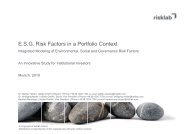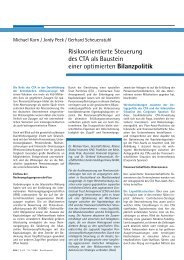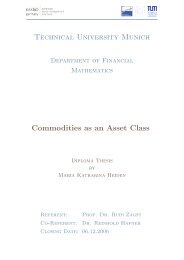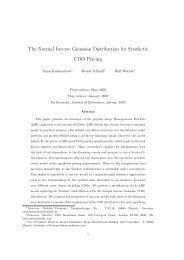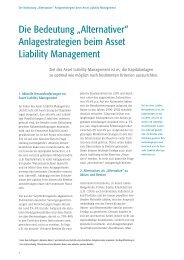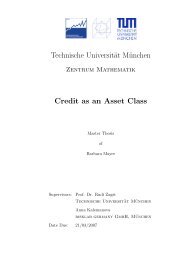Empirical Evaluation of Hybrid Defaultable Bond Pricing ... - risklab
Empirical Evaluation of Hybrid Defaultable Bond Pricing ... - risklab
Empirical Evaluation of Hybrid Defaultable Bond Pricing ... - risklab
You also want an ePaper? Increase the reach of your titles
YUMPU automatically turns print PDFs into web optimized ePapers that Google loves.
Table 10: Average R 2 values (out—<strong>of</strong>-sample) <strong>of</strong> the different models based on<br />
data from October 1, 1993, to June 1, 2001.<br />
Rating Class SZ Ext. SZ Bakshi et al<br />
Industrials BBB1 0.394 0.416 0.326<br />
Industrials A2 0.300 0.422 0.264<br />
Treasury Strips 0.737 0.769 0.824<br />
<strong>of</strong> modeling the structural differences <strong>of</strong> bond prices through time. This<br />
is caused by the greater ßexibility <strong>of</strong> the spread process. Our empirical<br />
analysis shows that the short rate spread s has a higher correlation with<br />
short rate interest rates, whereas the uncertainty index u has a higher<br />
correlation with long term interest rates (see Table 12).<br />
Table 11: Correlations <strong>of</strong> the processes s and u in the model <strong>of</strong> Schmid and<br />
Zagst with the observed BBB1 spreads for different maturities.<br />
Observed spreads with maturities (in years)<br />
0.25 0.5 1 2 3 4 5 7 10 20 30<br />
s 0.84 0.89 0.82 0.62 0.55 0.47 0.46 0.42 0.44 0.39 0.42<br />
u 0.61 0.63 0.83 0.94 0.97 0.96 0.99 0.99 0.98 0.98 0.98<br />
Table 12: Correlations <strong>of</strong> the processes s and u in the extended model <strong>of</strong> Schmid<br />
and Zagst with the observed BBB1 spreads for different maturities.<br />
Observed spreads with maturities (in years)<br />
0.25 0.5 1 2 3 4 5 7 10 20 30<br />
s 0.84 0.90 0.86 0.69 0.62 0.53 0.53 0.49 0.50 0.45 0.48<br />
u 0.63 0.65 0.84 0.94 0.97 0.96 0.98 0.99 0.98 0.99 0.98<br />
• This result is further backed by the behavior <strong>of</strong> the functions C d (t, T )/(T −<br />
t) and D d (t, T )/(T − t) (that basically show the dependence <strong>of</strong> S (t, T ) on<br />
s and u) forÞxed t. While both functions converge to 0 as T tends to<br />
∞, they show a different behavior in the time interval relevant for us (see<br />
Figures 6 and 7): C d (t, T )/(T − t) is monotonically decreasing towards 0,<br />
22



